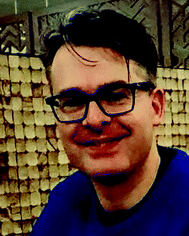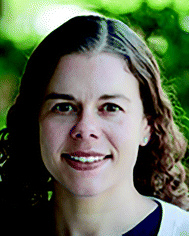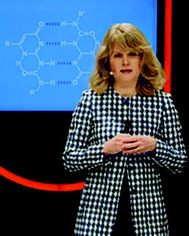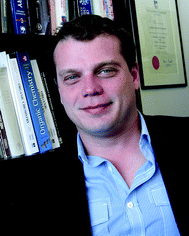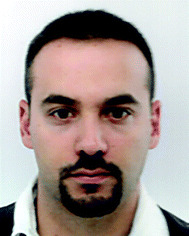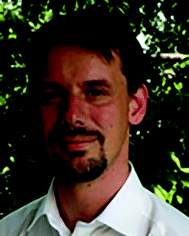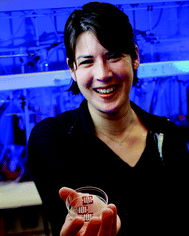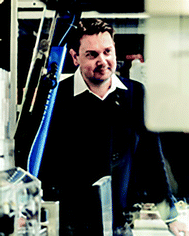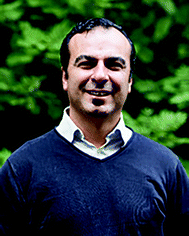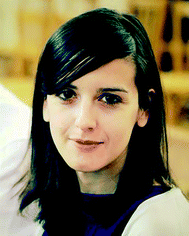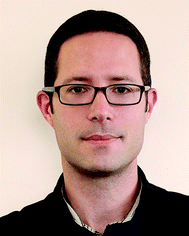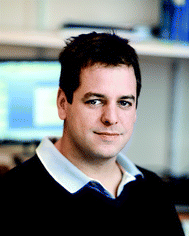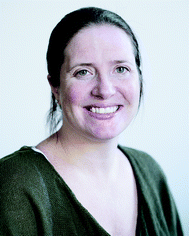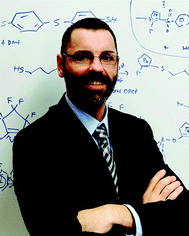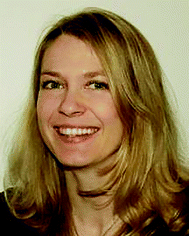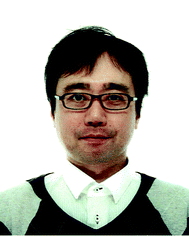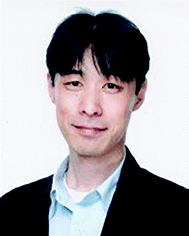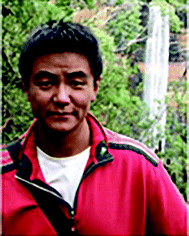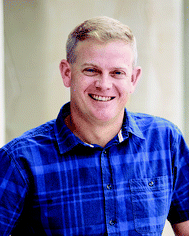DOI:
10.1039/C7PY90121F
(Editorial)
Polym. Chem., 2017,
8, 4904-4915
Pioneering Investigators 2017
 Eva Harth | University of Houston, USA |
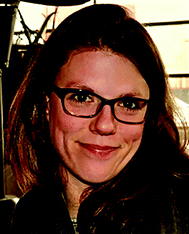 Emily Pentzer | Case Western Reserve University, USA |
We are pleased to present a new themed issue format that Polymer Chemistry is offering its esteemed readership in this inaugural issue. The “Pioneering Investigators” issue will highlight the work of mid-career investigators who have firmly established themselves in the field of polymer chemistry and continuously publish creative, innovative work and have pioneered, and enriched several research areas. These investigators, who have been often previously identified as ‘emerging investigators’ have been selected to serve as representatives of the growing importance and significance of specialized fields with high future impact. We are excited to include in this first issue, the contribution of 32 articles and 3 reviews. This issue covers the latest advances in the development of advanced polymerization methodologies, including precision polymers and living free radical polymerization, as well as the use of polymer chemistry to understand and define how chemical architectures dictate properties for the optimization of performance in biomaterials or materials for nanomedicine. The work presented herein will undoubtedly impact multiple fields for decades to come.
Developing innovative and novel polymer methodologies
has motivated the work of Pyun et al. (DOI: 10.1039/c7py00587c). This work presents an elegant new process termed “dynamic covalent polymerization” (DCP) that circumvents the limitation of sulfur solubility in vulcanization strategies by utilizing poly(sulfur-random-styrene) in a thermally driven activation process to generate sulfur radicals that add to vinylic monomers, which cannot otherwise incorporate elemental sulfur. This methodology allows for the direct integration of sulfur into terpolymers (CHIPs) with improved electrochemical and optical properties. Nicolaÿ et al. (DOI: 10.1039/c7py00875a) report on new methodologies to prepare molecular brushes with adjustable grafting-density, side-chain nature, and degree of polymerization by combining thiol-initiated polymerization and telomerization to polythiol macrotransfer agents in a one-pot, two-step or two-pot sequence. Luscombe et al. (DOI: 10.1039/c7py00435d) used DFT calculations to design an indacenodithiophene-based conjugated polymer that showed low stiffness and high ductility for use in OFETs; the polymer is in a rubber state at room temperature and shows minimal conformational changes between solution and the solid state. Seferos et al. (DOI: 10.1039/c7py00512a) demonstrated the synthesis of porous films of a novel class of n-type polymers that can reversibly undergo negative and positive charging, demonstrating conjugated polymer pseudocapacitors over relatively high operating voltages. Uemura et al. (DOI: 10.1039/c7py00309a) report the effect of macromolecular alignment and its influence on polymer properties and how this system is enabled by the use of a porous coordination polymer (PCP) as a template. Due to the extended conjugation, the resulting particles exhibit superior conductivity. Bon et al. (DOI: 10.1039/c7py00308k) provided an in depth analysis of Pickering emulsion polymerizations and found that the adhesion of inorganic nanoparticles to the emulsion interface is driven by a heterocoagulation event in the water phase.
Rieger et al. (DOI: 10.1039/c7py00302a) report anisotropic and high glass transition core–shell nanofibers prepared by polymerization induced self-assembly (PISA) and their use as reinforcing fillers for water-based acrylic materials. Boyer et al. (DOI: 10.1039/c7py00007c) report an approach to synthesize several polymeric architectures, block and star polymers as well as self-assembled nanoparticles (via PISA) in an oxygen tolerant photopolymerization RAFT process in water at ultralow volumes. This method opens up possibilities for screening reaction parameters and preparing biopolymer conjugates from sparse biological materials. O'Reilly et al. (DOI: 10.1039/c7py00219j) reported the synthesis of N,N′-(dimethylamino)ethyl acrylate (DMAEA) star polymers using an arm-first approach and RAFT polymerization and revealed a strong temperature dependence on the hydrolytic behavior of the materials, but noted that the composition and nature of the arm had little impact on hydrolysis. Lutz et al. (DOI: 10.1039/c7py00496f) reported on the development of sequence-coded oligourethanes as macroinitators with the ability to form well-defined blocks using ATRP methods that can store digital information as traceable sequence-coded barcodes. Satoh et al. (DOI: 10.1039/c7py00324b) reported on a method to control copolymer sequence distributions from interconvertible multiblock to kinetic blocks. The so called “one-shot” copolymerization included radical and dual radical and cationic polymerization using RAFT agents as a dual mediator. Harrisson et al. (DOI: 10.1039/c7py00495h) applied RAFT polymerization techniques to produce copolymers of N-isopropyl acrylamide (NIPAM) and vinyl acetate (VAc), resulting in a ‘one-pot’ amphiphilic gradient copolymer with a single and broad glass transition that is usually only found for corresponding block copolymers. Self-assembly in water suggested the formation of dynamic aggregates. Guillaneuf et al. (DOI: 10.1039/c7py00337d) studied the kinetics of conventional free-radical polymerization of seven-membered cyclic ketene acetal monomers to identify the key parameters for adjusting the kinetics and resulting molar masses. This study demonstrated that the polymerization kinetics are strongly driven by the nature of the propagating radical. Patton et al. (DOI: 10.1039/c6py01563h) demonstrated the first example of the controlled radical polymerization of monomers containing unprotected acyl hydrazide pendent groups using aqueous RAFT polymerization under acidic conditions, facilitated by a novel imidazolium-based trithiocarbonate CTA. D'Agosto et al. (DOI: 10.1039/c7py00344g) reviewed state-of-the-art dual reversible-deactivation radical polymerization (RDRP) techniques that allow for the elegant preparation of complex structures by the incorporation of multiple controlling functionalities in the same species, removing the need for chemical transformations between polymerization steps.
Ladmiral et al. (DOI: 10.1039/c7py00346c) introduce CuAAC click coupling to prepare highly desirable (PVDF-b-PDMAEMA) block copolymers from azide and alkyne functionalized homopolymers made via RAFT or ATRP polymerization techniques. Self-assembly in water yielded morphologies of spherical aggregates and cylindrical micelles. Drockenmuller et al. (DOI: 10.1039/c7py0046k) developed a difunctional triazolium-based diol monomer for the synthesis of ionic polyurethanes in a step growth polymerization with commercial diisocyanates. Miller et al. (DOI: 10.1039/c7py00205j) demonstrated the use of commercial polyvinyl alcohol (PVA) as a substrate that can be modified by acetalization with a series of sustainable aromatic aldehydes, and thoroughly evaluated the impact on the thermal properties of the system, as well as the ability to hydrolyze the novel functional groups under acidic conditions. Takeuchi et al. (DOI: 10.1039/c7py00333a) employed double-decker dinickel complexes as catalysts for ethylene polymerization and showed increased catalytic activity and the formation of a polyethylene fraction with higher crystallinity, a less branched structure, and higher molecular weight due to the cooperative effect of the two nickel centers. Ouchi et al. (DOI: 10.1039/c7py00638a) present a comprehensive review on ring expansion polymerizations, focusing on the cationic polymerization of vinyl ethers using a cyclic hemiacetal ester along with the history of ring-expansion polymerization, highlighting methods to prepare cyclic polymers with unique topologies.
Integration of functional groups into polymers is fundamental to polymer chemistry as this enables the preparation of novel materials with novel properties and functions. For example, Malkoch et al. (DOI: 10.1039/c7py01097d) provided a facile synthetic pathway to modify hydroxyl functionalized substrates with reactive thiol-units derived from unsymmetrical disulfides, which will enable robust access to precursors used in thiol–ene “click-chemistry”. Dove et al. (DOI: 10.1039/c7py00358g) show a new approach for preparing thermally responsive aliphatic polycarbonates by improving the access of allyl functionalized polycarbonates, and subsequently the access to polymers with lower critical solution temperatures by thiol–ene coupling post-modification reactions. Ayres et al. (DOI: 10.1039/c7py00204a) present shape-memory foams for use as cardiovascular implants, which are formed through heparin-inspired segments in networks of crosslinked polyurethane/urea, showing tunable glass transitions without the loss of the shape-memory effect. Savin et al. (DOI: 10.1039/c7py00342k) prepared hollow nanoparticles from sacrificial silica templates as alternatives to self-assembly driven or crosslinked micelles for use as dispersants in oil spill remediation. The amphiphilic capsules are capable of stabilizing hydrocarbons in aqueous solutions. Berda et al. (DOI: 10.1039/c7py00320j) present a method to fold single polymer chains into nanoparticles using thermal Diels–Alder (DA) chemistry. For this, either a chain internal crosslinking process using copolymers with both reactive entities integrated was employed, or external multifunctional crosslinkers were used.
Biomedical applications
of polymeric materials for the fabrication of tissue engineering scaffolds have inspired the work of Burdick et al. (DOI: 10.1039/c7py00323d) who prepared photocurable poly(glycerol sebacate) biodegradable elastomers for easier processing and tunable tensile properties and degradation rates. Grunlan et al. (DOI: 10.1039/c7py00944e) reported PEO-silane amphiphiles that were able to restructure at the interface of modified bulk silicone and water to give superior hydrophilicity and protein resistance. Dankers et al. (DOI: 10.1039/c7py00801e) demonstrated the incorporation of a reactive additive to enable an inverse electron demand Diels–Alder cycloaddition with mono, di-functionalized bicyclononyne (BCN) and star PEG BCN, showing an enhanced antifouling behavior of the latter on supramolecular elastomers containing UPy-tetrazine groups. Tao et al. (DOI: 10.1039/c7py00112f) reported on the development of a chitosan-based self-healing hydrogel and its use as an injectable drug carrier for in vivo intra-tumor therapy of Taxol, avoiding a fast leaking of the drug.
Functionalized nanoparticles are the center of investigation in targeted nanomedicine approaches. A comprehensive review article by Mura et al. (DOI: 10.1039/c7py00559h) addresses the importance of nanomedicine to the medical field and emphasizes the need of relevant tumor models for preclinical evaluation by highlighting multicellular tumor spheroids (MCTS), which serve as 3D tumor models for a predictive in vitro evaluation of nanomedicines. Christman, Gianneschi et al. (DOI: 10.1039/c7py00568) show for the first time enzyme-directed-assembly of intravenously delivered nanoparticles in ischemic skeletal muscle, a muscle prevalently damaged in peripheral artery disease (PAD) with no accumulation in healthy muscle. De Geest et al. (DOI: 10.1039/c6py02192a) developed a poly(glycerol sebate) biodegradable and biocompatible polymer and demonstrated its use as a nanocarrier for hydrophobic drugs in a solvent displacement method, demonstrating the in vitro efficacy of the system.
Cladribine-based polymer prodrug nanoparticles, generated by “drug-initiated” RAFT polymerization provide insight into necessary structural design parameters manipulating the drug/polymer linkage, choice of monomer and polymer chain length, as presented by Nicolas et al. (DOI: 10.1039/c7py00536a). Sumerlin et al. (DOI: 10.1039/c7py00196g) reported a stimuli responsive drug delivery system based on the assembly of block copolymers containing one block of N-(2-hydroxypropyl)methacrylamide (HPMA) in which release of the small molecule drug under acidic conditions improved the biocompatibility of the polymer. The selectivity towards acidic environments is an attractive parameter to achieve tailored drug release to specific areas in cancer treatments. Thurecht et al. (DOI: 10.1039/c7py00345e) prepared polymer–prodrugs with the ability to alter the 19F MRI contrast during drug release, providing the basis for a next generation theranostic to identify the site of interest and quantify the payload release.
We would like to thank all authors who contributed to this inaugural “Pioneering Investigators” themed issue for their excellent contributions and hard work to make it possible. Special thanks are also given to the Polymer Chemistry editorial board and Royal Society of Chemistry editorial staff for supporting the new themed issue format initiative, which gave us the chance to highlight outstanding investigators in the fields.
Neil Ayres received his PhD training under Prof. David Haddleton at the University of Warwick, where his thesis was focused on surface-initiated atom transfer radical polymerization. After graduating in 2003, he worked as a post-doc for Prof. Charles McCormick at the University of Southern Mississippi, then Prof. William Brittain at the University of Akron, and also Prof. David Grainger at the University of Utah. He became an Assistant Professor in the Department of Chemistry at the University of Cincinnati in 2008, and was promoted to Associate Professor with Tenure in 2014. His research group is focused on preparing new biomaterials using polyureas and polyurethanes that are inspired by heparin, and understanding how the chemical structure of the polymers can influence the materials blood compatibility.
Erik Berda received a BS in Chemistry from Penn State in 2003 where he was introduced to polymer science in the research group of Prof. Harry Allcock. After a completing a PhD in organic chemistry with Prof. Ken Wagener at the University of Florida (2008) and postdoctoral training with Prof. Bert Meijer at TU/e (Eindhoven, NL), Erik joined the faculty at the University of New Hampshire in 2010 where he is currently an Associate Professor of Chemistry and Materials Science. Erik was recognized by both
Chemical Communications and
Polymer Chemistry as an “Emerging Investigator,” is the recipient of the Army Research Office Young Investigator Award, and currently serves as Secretary of the ACS Division of Polymer Chemistry. The Berda Group research focuses on defined nanostructure synthesis through manipulation of single polymer molecules and on the design and synthesis of functional and responsive polymers.
Stefan A. F. Bon is a full professor in the Department of Chemistry at the University of Warwick. He has studied chemical engineering at the Eindhoven University of Technology (TUe) in the Netherlands (cum laude, 1989–1993). He did his PhD (1993–1998) in the polymer chemistry group of Prof. Dr ir. Anton L. German at TUe, after which he worked as a post-doctoral research assistant in the group of Prof. David M. Haddleton at the University of Warwick (1998–2000). He was appointed as Unilever Lecturer in Polymer Chemistry at the University of Warwick in January 2001. During this period of research he focussed on the mechanistic aspects of living radical polymerisation in both homogeneous and heterogeneous systems, including the first ever living radical polymerization performed in emulsion. From 2005 Stefan Bon shifted his research interests to supracolloidal chemical engineering. Research in the BonLab (http://www.bonlab.info) has strong links with industry and involves the design of assembled supracolloidal structures and the synthesis of their colloidal and macromolecular building blocks through a combination of polymer chemistry, colloid science, soft matter physics, and chemical engineering. Current work focuses on autonomous responsive gels, active colloids, Pickering stabilization, synthesis of polymer and inorganic colloids, and materials made from colloids.
Cyrille Boyer received his PhD from the University of Montpellier II. After working with Dupont Performance Elastomers, Cyrille moved to UNSW in the centre for advanced macromolecular design. Cyrille’s research has been recognized by several international awards, including the ACS Biomacromolecules/Macromolecules Award and the Journal of Polymer Science Innovation Award. Cyrille's research interests mainly cover the use of photoredox catalysts to perform living radical polymerization and polymer post-modification, hybrid organic–inorganic nanoparticles for imaging and drug delivery.
Jason A. Burdick is a Professor of Bioengineering at the University of Pennsylvania. Jason’s research involves the development of biomaterials for various biological applications and his laboratory is specifically interested in understanding and controlling polymers on a molecular level to control overall macroscopic properties. The applications of his research range from controlling stem cell differentiation through material cues to fabricating scaffolding for regenerative medicine and tissue repair. Jason currently has over 200 peer-reviewed publications and has been awarded a K22 Scholar Development and Career Transition Award through the National Institutes of Health, an Early Career Award through the Coulter Foundation, a National Science Foundation CAREER award, a Packard Fellowship in Science and Engineering, and an American Heart Association Established Investigator Award. He is on the editorial boards of
Tissue Engineering,
Biomacromolecules,
Biofabrication, and
Journal of Biomedical Materials Research A, and is an Associate Editor for
ACS Biomaterials Science & Engineering.
Karen L. Christman is a professor in the Department of Bioengineering and the Associate Dean for Students in the Jacobs School of Engineering at UC San Diego. She received her B.S. in Biomedical Engineering from Northwestern University in 2000, and her PhD from the UC San Francisco and Berkeley Joint Bioengineering Graduate Group in 2003. She was also a NIH postdoctoral fellow at UCLA in the fields of polymer chemistry and nanotechnology. Dr Christman joined the Department of Bioengineering at UC San Diego in 2007. Her lab focuses on developing novel biomaterials for tissue engineering and regenerative medicine applications, and has a strong translational focus with the main goal of developing minimally invasive therapies for cardiovascular disease. Dr Christman is a fellow of the American Heart Association and the American Institute for Medical and Biological Engineering, and has received several awards including the NIH Director’s New Innovator and Transformative Research Awards, the American Heart Association Western States Innovative Sciences Award, and the Tissue Engineering and Regenerative Medicine Society’s Young Investigator Award.
Franck D’Agosto is CNRS research director at the University of Lyon in the Chemistry, Catalysis, Polymers and Processes (C2P2) group. He completed a PhD in Polymer Chemistry at the joined unit between CNRS and bioMérieux (University of Lyon, France) before working at the University of Sydney (Australia) as a postdoctoral fellow at the Key Center for Polymer Colloids. He received the Bronze CNRS Medal in 2006 and the 2010 award of the French Chemical Society – Polymer Division. His research interests focus on the control of polymer architectures by the use of different polymerization chemistries, such as catalytic and controlled radical polymerizations – either performed in solution or in dispersed media.
Patricia Y. W. Dankers is an associate professor in the Department of Biomedical Engineering and the Institute for Complex Molecular Systems, at the Eindhoven University of Technology, the Netherlands. She obtained her master’s degree in chemistry from the Radboud University Nijmegen, her first PhD in technical natural sciences from the Eindhoven University of Technology (2006), and her second PhD in medical sciences from the University of Groningen (2013). Her particular research interests are on the design and synthesis of bioinspired functional biomaterials to be used in various biomedical applications. Besides her passion for scientific research, she also loves to promulgate science to the general public, and she enjoys teaching her two little sons about chemistry of daily life.
Bruno De Geest graduated as a Chemical Engineer in 2003 from Ghent University where he obtained his PhD in pharmaceutical sciences in 2006 on ‘Polyelectrolyte Multilayer Capsules for Pharmaceutical Applications'. For his PhD work he was awarded the graduate student award for pharmaceutical technology from the AAPS and the Andreas Deleenheer award from Ghent University. After 2 years of postdoctoral research at Utrecht University (The Netherlands), he returned to Ghent University at the Department of Pharmaceutics. From October 2012 onwards, he is appointed as a professor in Biopharmaceutical Technology. Bruno De Geest has published over 130 papers and leads an interdisciplinary lab that works at the interface between materials chemistry and life science. In particular, research efforts are endeavored into the development of interactive polymeric systems for anti-cancer immuno- and chemo-therapy.
Andrew P. Dove graduated from the University of York with an MChem degree in 1999. His subsequent PhD studies were conducted under the supervision of Prof. Vernon C. Gibson FRS at Imperial College, London, focused on metal catalysed co-ordination insertion polymerisation. Andrew undertook post-doctoral research first under the guidance of Prof. Robert M. Waymouth at Stanford University, California, and then as a CIPMA post-doctoral fellow at IBM, San Jose, California, under the supervision of Dr James L. Hedrick and Prof. Robert M. Waymouth. Andrew returned to the UK to take up a RCUK Fellowship in Nanotechnology in September 2005 before being appointed as an Assistant Professor in September 2006 and subsequently as an Associate Professor in September 2009 before being appointed as a Full Professor in June 2014. His research is focussed on the development of novel degradable biomaterials and sustainable polymers. Andrew is an ERC consolidator grant holder, member of the Editorial Advisory Boards for
Biomaterials Science,
ACS Macro Letters,
Macromolecules and
Biomacromolecules, and has received several awards through his career that include the 2009 Macro Group UK Young Researcher Medal, 2014 RSC Gibson-Fawcett Award and 2016 Biomacromolecules/Macromolecules Young Researcher Award.
Eric Drockenmuller received his PhD degree in 2002 from the University of Strasbourg (France) after working on nitroxide mediated radical polymerization. He undertook a two years postdoctoral position with Prof. C. J. Hawker (IBM Almaden Research Center, California, USA) and Prof. T. P. Russell (University of Massachusetts, Amherst, USA) working on the application of robust, efficient and orthogonal methodologies for the synthesis and functionalization of nanostructured materials. He was appointed Assistant Professor in 2004 and Full Professor in 2011 at the University of Lyon 1 (France). From 2010 to 2015 he was a junior member of the “Institut Universitaire de France” (IUF). In 2015 he joined the group of Prof. T. Xu (University of California, Berkeley, USA) as a Fulbright grantee to work on self-assembled nanomaterials. His main interests include the synthesis and applications of tailored functional materials. In 2013 he pioneered the synthesis of poly(1,2,3-triazolium)s, a new class of poly(ionic liquid)s with potential applications as solid electrolytes and functional vitrimer materials.
Nathan C. Gianneschi received his B.Sc(Hons) at the University of Adelaide, Australia, in 1999. In 2005 he completed his PhD at Northwestern University. Following a Dow Chemical postdoctoral fellowship at The Scripps Research Institute, in 2008 he began his independent career at the University of California, San Diego, where he is currently a Teddy Traylor Scholar and Professor of Chemistry & Biochemistry, NanoEngineering and Materials Science & Engineering. The Gianneschi group takes an interdisciplinary approach to nanomaterials research with a focus on multifunctional materials with interests that include biomedical applications, programmed interactions with biomolecules and cells, and basic research into nanoscale materials design, synthesis and characterization. For this work he has been awarded the NIH Director's New Innovator Award, the NIH Director's Transformative Research Award and the White House's highest honor for young scientists and engineers with a Presidential Early Career Award for Scientists and Engineers. Prof. Gianneschi was awarded a Dreyfus Foundation Fellowship, is a Kavli Fellow of the National Academy of Sciences, a Fellow of the Royal Society of Chemistry, and an Alfred P. Sloan Foundation Fellow.
Melissa Grunlan is currently a Full Professor of Biomedical Engineering at Texas A&M University (TAMU) (http://grunlanlab.tamu.edu). She is also a faculty member of the Department of Materials Science & Engineering. Prof. Grunlan obtained her B.S. in Chemistry (1995) and M.S. in Polymers in Coatings (1997) from North Dakota State University (Fargo, ND). She was then employed with the H.B. Fuller Company (St. Paul, MN) for four years (1997–2001). In 2004, she received her PhD in Chemistry from the University of Southern California (Los Angeles, CA) and afterwards completed a post-doc at TAMU’s Department of Chemistry. Prof. Grunlan joined Texas A&M University as an Assistant Professor in August 2005. Her recent awards for research and teaching include the Royal Academy of Engineering Distinguished Visiting Fellowship (2015–2016), The Association of Former Students University–Level Award in Teaching (2016–2017), and the Texas A&M University Presidential Impact Fellowship (Inaugural class, 2017). She is Chair-Elect of the American Chemical Society (ACS) Division of Polymeric Materials: Science and Engineering. Her research is broadly focused on developing new polymeric materials to improve the performance of medical devices and regenerative therapies. Several specific research areas include anti-fouling coatings for blood-contacting devices and industrial applications, self-cleaning membranes for implanted biosensors, shape memory polymer scaffolds for bone tissue regeneration and hybrid hydrogel scaffolds for osteochondral regeneration.
Yohann Guillaneuf completed his PhD in 2006 under the supervision of Prof. Denis Bertin at the University of Provence (France), where he studied the kinetics of the nitroxide-mediated polymerization. He then joined the group of Prof. Robert G. Gilbert at the University of Sydney (Australia) and University of Queensland (Brisbane, Australia), as a postdoctoral researcher in both the field of controlled radical polymerization in dispersed media and polysaccharides. In 2010, he obtained a CNRS researcher position at the Institute of Radical Chemistry (Aix-Marseille Université) in Marseille (France). His current research activities deal with advanced macromolecular synthesis
via the photo-controlled radical polymerization and the radical ring-opening polymerization. He is (co)author of more than 65 peer-reviewed articles in international journals and 5 patents.
Simon Harrisson is a Chargé de Recherche at the Centre National de la Recherche Scientifique (CNRS), based in the Laboratoire des IMRCP in Toulouse. He obtained a PhD from the University of New South Wales, Australia, in 2002. After postdoctoral fellowships at the University of Warwick and Washington University in St Louis, he joined the Commonwealth Scientific and Industrial Research Organisation (CSIRO) in 2005. In 2010 he moved to France, working at the Institut Galénique at the Université de Paris-Sud and the Solvay Research & Innovation Center Paris, before joining the CNRS in 2014. Dr Harrisson has published over 60 peer-reviewed research papers and book chapters. His research seeks to apply a fundamental understanding of polymerization kinetics and mechanisms to the development of new materials.
Vincent Ladmiral did his undergraduate studies in Montpellier (ENSCM, France) and received his PhD from the University of Warwick (UK) in 2006. He then worked as a postdoctoral associate at Kyoto University (Japan), at the University of Sydney (Australia), at the University of New South Wales (Australia) and at the University of Sheffield (UK). In 2012 he was recruited by CNRS as a research scientist at the Institute for Molecular Chemistry and Material Sciences in Montpellier (France). His main research interests pertain to the study of electroactive fluoropolymers. His research focuses on the synthesis of well-defined fluoropolymer architectures and on the self-assembly of these architectures.
Christine Luscombe grew up in Kobe, Japan. After receiving her Bachelor’s degree in Natural Sciences from the University of Cambridge in 2000, she worked with Prof. Andrew Holmes and Prof. Wilhelm Huck in the Melville Laboratory of Polymer Synthesis at the University of Cambridge where her research focused on surface modifications using supercritical carbon dioxide for her PhD. She received the Syngenta Award for best organic chemistry project for her PhD. In January 2004, she joined the group of Prof. Jean Fréchet for her post-doctoral studies where she began her research on semiconducting polymers for organic photovoltaics. She was the recipient of the Lindemann Fellowship as well as the Trinity College Junior Research Fellowship (University of Cambridge) for her post-doctoral studies. In September 2006, she joined the Materials Science and Engineering Department at the University of Washington, Seattle. She received a number of young faculty awards including the NSF CAREER Award, DARPA Young Faculty Award, as well as the Sloan Research Fellowship. Her current research focuses on the synthesis of semiconducting polymers for energy applications. She has served on the Editorial Advisory Boards for
Macromolecules and
ACS Macro Letters, and is currently serving on the Editorial Advisory Boards for
Polymer International,
Advanced Electronic Materials, and
Journal of Applied Physics. She is an Associate Editor for
Journal of Materials Chemistry A, is serving on the IUPAC Polymer Education and Polymer Terminology Subcommittees, and is the Vice President of the IUPAC Polymer Division.
Jean-François Lutz is CNRS research director and deputy director of the Institut Charles Sadron located in Strasbourg, France. He received his doctoral degree from the University of Montpellier II in 2000 and his habilitation degree from the University of Potsdam in 2009. Before joining the CNRS, he was a post-doctoral fellow at Carnegie Mellon University (2001–2003) and afterwards leader of the research group Nanotechnology for Life Science at the Fraunhofer Institute for Applied Polymer Research (2003–2010). He is an author of over 150 publications as well as 10 patents, and serves as an Advisory Board member for several journals including
Polymer Chemistry. He is also an ERC laureate since 2010 through successive starting (StG 2010) and proofs of concept (PoC 2015) grants. Furthermore, he is listed since 2015 as an ISI Highly Cited Researcher in the category “Chemistry”.
Michael Malkoch is a professor in functional organic nanomaterials at KTH Royal Institute of Technology, Sweden. He received his PhD in polymer technology in 2003 from KTH Royal Institute of Technology under the supervision of Prof. Anders Hult. After, he joined Prof. Craig J. Hawker, between 2003 and 2005, as a postdoctoral fellow at Stanford University, IBM Almaden Research Center and finally the Materials Research Laboratory in Santa Barbara (UCSB). In 2007 and 2010, he was awarded two distinguished awards from the Swedish Research Council (VR) solidifying his academic independency. In 2012, he received the KAW Academy Fellow (2013) in Engineering Science. His research focuses on three main areas: 1) identifying novel and sustainable concepts to highly complex and functional macromolecules, 2) fabrication of functional soft networks for accelerated tissue regeneration, and 3) development of next generation materials for complex bone fractures.
In 1994
Stephen A. Miller received coterminal B.S. and M.S. degrees in Chemistry from Stanford University, where Robert M. Waymouth served as his undergraduate and M.S. Thesis advisor. He then earned a PhD in Chemistry at the California Institute of Technology in 1999 with John E. Bercaw before conducting postdoctoral research with Nobel Laureate Richard R. Schrock at the Massachusetts Institute of Technology during 2000–2001. He held the position of Assistant Professor of Chemistry at Texas A&M University from 2001 until 2007, when he accepted his current positions of Associate Professor of Chemistry and Member of the Butler Polymer Research Laboratory at the University of Florida. His primary research efforts target the synthesis of biorenewable and degradable polymers that mimic petroleum-based plastics. Novel synthetic methodologies have been applied to a variety of biogenic feedstocks, including sugars, triglycerides, lignin, and C1 feedstocks, yielding linear thermoplastic polymers with the potential to replace incumbent packaging plastics. Moreover, these polymers are generally amenable to biodegradation or water-degradation, affording benign metabolites already present in nature. He is a co-founder and the Chief Technology Officer of U.S. Bioplastics (http://usbioplastics.com/) and an alumnus of the Global Young Academy (http://globalyoungacademy.net).
Simona Mura gained a degree in Pharmaceutical Chemistry and Technology in 2005. In 2009, she was awarded her PhD in Chemistry and Technology of Drugs at the University of Cagliari, Italy, working on the design and
in vitro evaluation of novel vesicular systems for the topical delivery of drugs. In 2008 she joined the group of Prof. Elias Fattal (UMR CNRS 8612) at University Paris-Sud, Chatenay-Malabry, France, as a post-doctoral research assistant to study the lung toxicity of biodegradable nanoparticles designed for pulmonary administration of drugs. In 2011 she was appointed Associate Professor within the framework of the “CNRS-Higher Education chairs (Chaire d’excellence)” program, in the group of Prof. Patrick Couvreur (UMR CNRS 8612) at University Paris-Sud, Chatenay-Malabry, France. She possesses a strong background in the formulation/characterization and
in vitro evaluation of drug delivery systems and a solid knowledge in the field of
in vivo cancer animal models. Her research focuses on the development of relevant and easy-to-handle
in vitro 3D models for the assessment of the therapeutic efficacy of novel nanoscale drug delivery systems and biopolymers for the treatment of severe neoplastic diseases.
Julien Nicolas completed his PhD in 2005 under the supervision of Prof. Bernadette Charleux at the University Pierre and Marie Curie in Paris (France), where he studied nitroxide-mediated polymerization in homogeneous and aqueous dispersed media. He then joined the group of Prof. David M. Haddleton at the University of Warwick (U.K.), as a postdoctoral researcher (Marie Curie Intra-European Fellowship) to work in the field of polymer–protein bioconjugates. In 2007, he obtained a CNRS researcher position at Institut Galien Paris-Sud (Univ. Paris-Sud) in Châtenay-Malabry (France) and was promoted to CNRS research director in 2016 in the group of Prof. Patrick Couvreur. His current research activities lie in advanced macromolecular synthesis and in the design of polymer-based nanomedicines, especially degradable vinyl materials, polymer nanoparticles and polymer prodrugs. He is (co)author of more than 80 peer-reviewed articles in international journals, 5 patents, and 13 book chapters. In 2016, he was appointed as Associate Editor of
Chemistry of Materials (ACS) and won the French Polymer Society (GFP)/French Chemical Society (SCF) award.
Renaud Nicolaÿ was trained as an “ingénieur” chemist at the Ecole Supérieure de Chimie Organique et Minérale before being awarded PhD degrees from Pierre & Marie Curie University in 2008 and from Carnegie Mellon University in 2009, working in the field of controlled radical polymerization under the supervision of Prof. Patrick Hémery and Prof. Krzysztof Matyjaszewski, respectively. In 2010, he joined the group of Prof. E. W. Meijer at Eindhoven University of Technology working as a postdoctoral researcher on supramolecular chemistry and single-chain polymeric nanoparticles. In September 2010, he was appointed as Assistant Professor at the École Supérieure de Physique et de Chimie Industrielles de la Ville de Paris (ESPCI Paris), where he joined the Soft Matter and Chemistry Laboratory directed by Prof. Ludwik Leibler. He is in charge of polymer chemistry classes at ESPCI Paris. His research focuses on macromolecular engineering, with particular emphasis on the design and development of dynamic organic and hybrid formulations and materials, such as vitrimers, as well as on the conception of new synthetic methodologies. He is (co)author of 30 peer-reviewed publications, 19 patents and was awarded the CNRS Bronze Medal in 2014.
Rachel K. O’Reilly graduated with 1st class honors from the University of Cambridge in 1999 and went on to complete her PhD at Imperial College, London, in 2003. She then moved to the US under the joint direction of Prof. Craig J. Hawker and Prof. Karen L. Wooley, and in 2004 was awarded a Royal Commission for the Exhibition of 1851 research fellowship. In 2005 she took up a Royal Society Fellowship at the University of Cambridge and then in 2008 she moved to the University of Warwick and in 2012 was promoted to Full Professor. Her group undertakes research in the fabrication of polymer nanostructures using advances in self-assembly and she also leads projects in the area of catalysis, responsive polymers, nanostructure characterization and DNA nanomaterials.
Makoto Ouchi is an Associate Professor at the Department of Polymer Chemistry, Graduate School of Engineering, Kyoto University. He received his PhD degree at Kyoto University in 2001. After his defence, he joined Toyota Central R&D Labs to develop poly(lactic acid)-based automobile resin. In 2004, he moved to Kyoto University to start his academic career as an Associate Professor and was promoted to an Associate Professor in 2010. He was concurrently appointed as a PRESTO researcher of Japan Science and Technology Agency (JST) for the project of “Molecular Technology” from 2013 to 2017. His current interests include development of precision polymerizations, particularly sequence-controlled polymerization and ring-expansion polymerization as well as development of active polymerization catalysts.
Derek L. Patton earned his B.S. in Chemistry (2000) from Jacksonville State University and his PhD in Chemistry (2006) from the University of Houston. In 2006, he moved to NIST (Gaithersburg, MD) as a NRC Postdoctoral Fellow in the Polymers Division, and in 2008, he joined the faculty in the School of Polymers and High Performance Materials at the University of Southern Mississippi. In 2014, Derek was promoted to Associate Professor with tenure. His research group focuses on the development of functional polymer surfaces using surface-initiated polymerization, postpolymerization modification reactions, and thiol-ene photopolymerization. He was awarded the NSF CAREER Award and the USM Junior Faculty Research Award in 2011, and the College of Science and Technology Faculty Research Award in 2015.
Jeffrey Pyun earned his PhD in Chemistry under the supervision of Prof. Krzysztof Matyjaszewski at Carnegie Mellon University, USA, in 2002. He then moved on to do postdoctoral research in a joint position with Prof. Jean M. J. Fréchet at U.C. Berkeley and Prof. Craig J. Hawker at the IBM Almaden Research Center. He is currently a Full Professor at the University of Arizona and at Seoul National University doing research in the area of polymers and materials chemistry for sustainability, energy, optics defense.
Jutta Rieger obtained her PhD degree in 2005 working on the synthesis and assembly of functional ε-caprolactone-based polymer architectures at CERM (University of Liège, Belgium, supervised by Christine Jérôme and Robert Jérôme) and at CERMAV (CNRS, France, under the supervision of Rachel Auzély-Velty). After briefly working for Macopharma at ICMMO (Orsay, France) in 2006, she joined Prof. Bernadette Charleux’s group in Paris at UPMC (Université Pierre et Marie Curie) in 2007 and started working on RAFT polymerization. Since 2009 she is an independent CNRS researcher at UPMC in the Laboratoire de Chimie des Polymères, which recently joined UPMC’s Institut Parisien de Chimie Moléculaire (IPCM). Her research focuses on the synthesis and characterization of functional polymeric materials using homogeneous or heterogeneous controlled radical polymerization processes, and in particular PISA (polymerization induced self-assembly).
Kotaro Satoh received his B.S. (1995), M.S. (1997), and PhD (2000) degrees in polymer chemistry from Kyoto University under the direction of Prof. Mitsuo Sawamoto. During 2000–2004, he worked for Tsukuba Research Laboratories, Kuraray Co Ltd. as a researcher to develop a novel thermoplastic elastomer. In 2004, he moved to Nagoya University as an Assistant Professor working with Prof. Masami Kamigaito and was promoted to an Associate Professor (current position) in 2007. In 2009–2010, he was a visiting scientist at the University of California, Santa Barbara, working with Prof. Craig J. Hawker. Since 2014, he concurrently serves as a PRESTO researcher of the Japan Science and Technology Agency (JST), involved in the project of “molecular technology and creation of new functions”. He received the Awards for the Encouragement of Research in Polymer Science of the Society of Polymer Science, Japan (SPSJ) (2008), The Young Scientists' Prize by the Minister of Education, Culture, Sports, Science and Technology, Japan (2012), SPSJ Asahi Kasei Award (2012), and SPSJ Wiley Award (2015). His research interests include exploring new precision polymerization systems, as well as developing polymer materials by means of well-defined polymerizations, and bio-based polymers from plant-derived renewable vinyl monomers.
Daniel Savin graduated from Harvey Mudd College (Claremont, CA) in 1995 with a B.S. in Chemistry and received an M.S. in Polymer Science and a PhD in Chemistry in 1997 and 2002, respectively, at Carnegie Mellon University under the direction of Prof. Gary Patterson. He continued this work as a Postdoctoral Fellow in the group of Prof. Timothy Lodge at the University of Minnesota from 2002–2003. In 2003 he joined the Department of Chemistry at the University of Vermont as an Assistant Professor and in 2008 he moved to the School of Polymers and High Performance Materials at the University of Southern Mississippi. In January 2015, Savin joined the Department of Chemistry at the University of Florida as part of their Preeminence initiative in Smart Polymer Nanomedicine.
Dwight Seferos is currently an Associate Professor of Chemistry, Chemical Engineering, and Canada Research Chair in Polymer Nanomaterials at the University of Toronto. He completed a BSc in 2001 form Western Washington University, a PhD in 2006 with Gui Bazan at UCSB, and was an American Cancer Society Postdoctoral Fellow with Chad Mirkin at Northwestern before beginning his independent career at the University of Toronto in 2009. Research in the Seferos group concerns the design, synthesis, characterization and device engineering of organometallic and organic materials, specifically those composed of selenophene and tellurophene. Seferos has authored or coauthored over 90 publications, holds numerous patents, and has been recognized by several national and international awards, including the DuPont Young Professor Award and Alfred P. Sloan Research Fellowship.
Brent Sumerlin graduated with a B.S. from North Carolina State University in 1998 and received his PhD in 2003 from the University of Southern Mississippi under the direction of Dr Charles McCormick. He continued his work as a Visiting Assistant Professor/Postdoctoral Research Associate in the group of Krzysztof Matyjaszewski at Carnegie Mellon University from 2003–2005. In 2005 he joined the Department of Chemistry at Southern Methodist University as an Assistant Professor, and in 2009 he was promoted to Associate Professor with tenure. In the fall of 2012, Prof. Sumerlin joined the Butler Polymer Research Laboratory and the Center for Macromolecular Science & Engineering within the Department of Chemistry at the University of Florida, where he is currently a Professor. He is a Fellow of the Royal Society of Chemistry and has received several awards, including the Alfred P. Sloan Research Fellowship, NSF CAREER Award,
Journal of Polymer Science Innovation Award, and the
Biomacromolecules/
Macromolecules Young Investigator Award.
Daisuke Takeuchi was born in 1972 in Ishikawa, Japan. He received his M. Eng. degree (1996) from the University of Tokyo under the direction of Prof. Takuzo Aida. In 1998, he joined Tokyo Institute of Technology as a Research Associate in the Group of Prof. Takeshi Endo, where he received his PhD degree (2000). He joined the group of Prof. Kohtaro Osakada in 2000 as an Assistant Professor and was promoted to an Associate Professor in 2006. His research interests include the development of new metal complex catalysts and new polymerization reactions.
Lei Tao received his Bachelor and Master degrees from the University of Science and Technology of China in 1999 and 2002, respectively. He then joined Prof. David Haddleton’s group and received his PhD in 2006. After two post-doc experiences at the University of Califonia, Los Angeles (UCLA, Prof. Heather Maynard, 2006–2008) and the University of New South Wales (UNSW, Prof. Thomas Davis, 2008–2010), Dr Tao joined the Department of Chemistry, Tsinghua University, as an associate professor. Dr Tao’s research interests include: 1) multicomponent click (MCC) reactions for functional polymers, 2) multicomponent polymerization systems for new functional polymers, and 3) self-healing hydrogels for bio-applications. Dr Tao has published more than 130 papers, which have received more than 5600 citations, and his h-index is 47.
Kris Thurecht is a group leader in the Centre for Advanced Imaging and the Australian Institute for Bioengineering and Nanotechnology at the University of Queensland, and is a Chief Investigator in the Australian Research Council Centre of Excellence in Convergent BioNano Science and Technology. His research focuses on the development of polymer and nanoparticle-based devices for nanomedicine. His team works across the boundaries of chemistry and materials, biology and imaging science to probe how nanomaterial properties affect their function in living animals. He is chair-elect of the Royal Australian Chemical Institute Polymer Division.
Takashi Uemura received his PhD under the supervision of Prof. Yoshiki Chujo at the Department of Polymer Chemistry, Kyoto University, in 2002. He then joined the Department of Synthetic Chemistry and Biological Chemistry at Kyoto University as an assistant professor, and has been an associate professor since 2010. He has also been a research director for a CREST program of the Japan Science and Technology Agency (JST) since 2013. He was awarded The Chemical Society of Japan Award for Young Chemists (2010), Kao Research Initiative Award (2014), JSPS Prize (2016), and so on. His research interests focus on the development of polymer chemistry and material science in confined nanospaces, in particular, controlled polymerizations using nanochannels of porous frameworks and the preparation of synergistic nanohybrids between porous hosts and polymeric materials.
|
| This journal is © The Royal Society of Chemistry 2017 |
Click here to see how this site uses Cookies. View our privacy policy here. 




